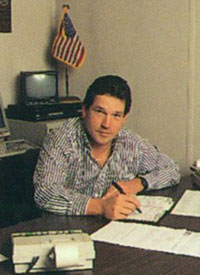Sweeping Up Milling Debris |
Safety: All-Important When Sweeping on Milling JobsitesSweeping on paving/re-paving jobsites is perhaps the most dangerous of all sweeping jobs.by Ranger Kidwell-RossIn June and July of 2007, I was contacted about two instances of serious injury involving a sweeper and a flagman. Both were on milling jobs and involved a ground worker being backed into by a sweeper. Unfortunately, one of these was a fatality. In both cases, due to onsite noise, the worker was unable to hear the sweepers backup alarms, both of which were operating normally. Operating a sweeper during re-paving operations is never the same from one jobsite to the next. For that reason, only experienced sweeping companies usually even bid on the jobs. Then, only senior operators are sent to operate sweepers on milling sites. Even then, accidents happen. Primarily, this is due to the variable nature of what occurs during paving operations. All types of roadways are paved, which creates many different scenarios for how both the sweepers and all the rest of the jobsite equipment operate. Also in play is what might be called 'the rush factor.' Many milling operations have strict lane closure times that must be adhered to, and the nature of the sweeping function means the sweeper often still has work to do when the majority of the rest of the crews go home. When this occurs, the sweeper operator is sometimes left on the job without the proper safety personnel or equipment. For example, an attenuator may not be needed while flaggers are onsite, but be necessary if flaggers are no longer present. Another factor is that the sweeper, which in most other types of sweeping jobs is on its own, is often mixed in closely with the rest of the equipment and personnel on milling jobsites. This naturally increases the likelihood of accident or injury to ground personnel. As a quick checklist, on milling jobsites:

Following are links to audio interviews with two long-time sweeping industry veterans with many years of experience with sweeping on milling jobs, as well as with other types of sweeping. In their interviews, these contractors each provide their take on dealing with safety on paving jobsites. Mike Lucht, president of Progressive Sweeping, Inc., has been a sweeping contractor for 30 years. Mike is also a founding Board Member and past president of what is now the North American Power Sweeping Association (NAPSA). Click here to listen to his mp3 audio interview, which is about 13 minutes in length (approximately 12mb in size). You may reach Mike Lucht via email sent to: mlucht@prosweep.com.
You may reach John Dubbioso via email sent to: jdubbioso@cloud9.net. If you have questions or comments about this article, please let us know. This article was added to WorldSweeper.com in 7.07. |
© 2005 - 2021
|
Back to Milling Table of ContentsSite Map / Table of Contents |